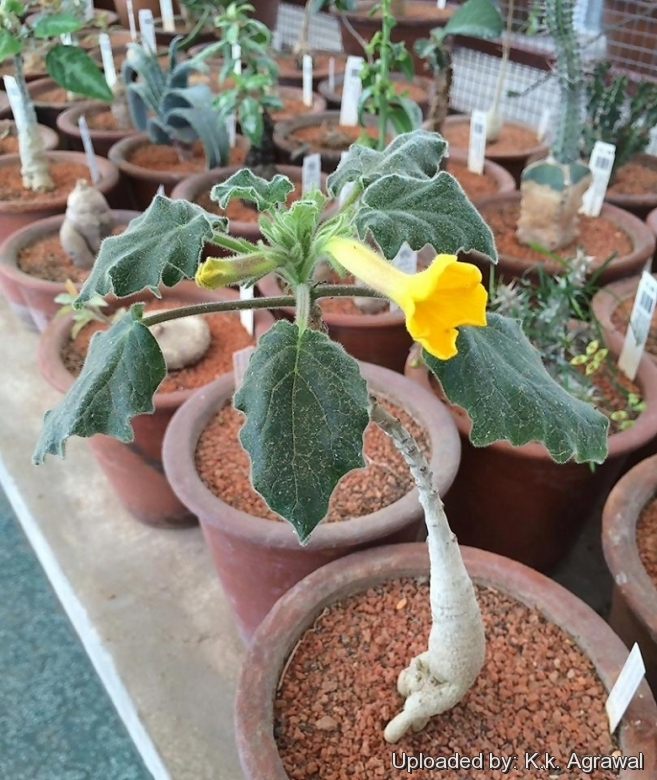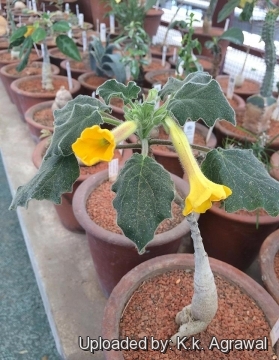




Your support is critical to our success.
- Encyclopedia of TREES
- Encyclopedia Index
- Families
- Genera
- Species
- Pedaliaceae
- Uncarina
- Caudiciforms
- Succulents
Since 4 Aug 2013

Origin and Habitat: Uncarina roeoeslianaSN|31008]]SN|31008]] is endemic to southwestern Madagascar Toliara/Anosy (Tolanaro District).
Altitude range: 100-500 metres above sea level.
Habitat and ecology: This species grows in tropical sub-arid deciduous savannah climate on limestone rocks.
Synonyms:
- Uncarina roeoesliana Rauh
Description: Uncarina roeoeslianaSN|15877]]SN|31008]] is a deciduous tropical shrub to 2 m tall, and the plant develops a nice irregular caudex at the base. It has the smallest flowers of all the Uncarina species presently known and appears to be related to Uncarina decaryiSN|18294]]SN|18294]] and Uncarina grandidieriSN|31008]]SN|15877]]. The many flowers are yellow with green centres and are shaped like those of petunias.
Stem: Stout, that becomes thickened with age. Stems may ultimately attain a height of 2 meters.
Leaves: There are two very distinct leaf forms: entire (subcordate) or (3-)5-lobed and more or less incised. They are finely hairy, soft, velvety and sticky to the touch. The leaves are deciduous during the winter resting season.
Flowers: Bright yellow flowers with with a green throat.
Blooming season: Warmer months.
Fruit: The fruit (capsules) are approx 3.5-5 cm long, bizarre looking with small inwardly pointed sticky "horns" looking like small hooked harpoons. They stick to about anything, using miscoscopic hooks on the end of each "horn", so don't touch this fruit unless you want to spend some time trying to remove it from your fingers.
Notes: “Pollination of uncarinias” by Chuck Hanson - Arid Lands Nursery
...The sexual parts of the flowers are normal, but the anthers never shed pollen. Instead, pollen-eating beetles push past the stigma lobe to get to the anthers. Each anther has a lobe that hangs down into the floral tube. The beetle begins feeding on this lobe. As it bites into the lobe, a slit pore above the lobe opens and pollen the consistency of toothpaste is deposited on the head and thorax of the beetle. When the beetle exits the flower, the stigma lobe offers no resistance. As the beetle enters another flower and pushes past the lower stigma lobe, the upper stigma lobe is moved down on top of the beetle and scrapes the pollen off, completing pollination.
Bibliography: Major references and further lectures
1) Werner Rauh, Herman Schwartz “Succulent and xerophytic plants of Madagascar”, Volume 2 Strawberry Press, 1998
2) Rauh, W. 1996. “Uncarina roeoesliana Rauh spec. nov., eine neue Art aus Südwestmadagaskar.” Kakteen And. Sukk. 47(1): 13–18.
3) Reference article Rauh, W. 1998. “Uncarina, die "Hakenstachelige": Eine nur auf Madagaskar vorkommende Gattung der Pedaliaceen.” Kakteen And. Sukk. 49(9): 205–209.
4) Reference article Rauh, W. 1998. “Blütenfarbe von Rosa bis Gelb: Zweiter Teil des Artikels über die Gattung Uncarina aus Madagaskar.” Kakteen And. Sukk. 49(10): 229–233.
5) http://www.alamy.com/stock-photo-yellow-flowers-of-uncarina-sp-peltata-pedaliaceae-growing-in-dry-forest-53049853.html
6) Bihrmann's caudiciforms “Uncarina roeoesliana” <http://www.bihrmann.com/caudiciforms/subs/unc-roe-sub.ASP>

Uncarina roeoesliana Photo by: K.k. Agrawal
The gallery now contains thousands of pictures, however it is possible to do even more. We are, of course, seeking photos of species not yet shown in the gallery but not only that, we are also looking for better pictures than those already present. Read More...
Cultivation and Propagation: Uncarinias are easy to grow heat resistant plant, which grow better than the average. Their attractiveness is further enhanced because they will flourish very easily in any pseudo-tropical environment. It can tolerate neglect, and as soon as you pay it a little attention (like repotting or fertilizing) it recovers and puts out plentiful new growth. They will tolerate intense heat and sun, when provided with adequate water, but must be protected from frost.
Growth rate: These plants can grow quite quickly if provided with adequate water, warmth and root run.
Soil: It needs a rich, very well drained potting medium (add pumice, vulcanite, and perlite).
Waterings: It should be watered plentifully in Summer and kept drier in Winter. This species like all Uncarinias, is sensitive to excess moisture, and should be kept on the dry side. It rot easily and do not like any water when it has no leaves.
Fertilization: Use diluted fertilizer on young plants to speed up growth.
Exposure: They do best when grown in part shade to full sun. G
Hardiness: Due to their Madagascan origin keep warm in winter, the minimum safe average temperature is 10°C, although they can go lower for short periods (cannot endure temperatures below 2° C). If grown outdoors they will probably grow back from roots, if frozen. They are quite heat tolerant, and survive easily temps above 45° in summer, without dropping leaves.
Bonsai/caudex culture: Lifting the thickened root system periodically creates a cool, gnarled bonsai look.
Reproduction: Seeds, and they can be reproduced by cuttings as well.
| Your Actions | |
|---|---|
| Back to Uncarina index | |
| Back to Pedaliaceae index | |
 |
Back to Trees Encyclopedia index |
Privacy stantement - Terms and conditions - How to cite - About us - Feedback - Donate


